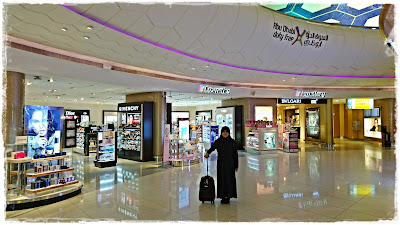“Be not afraid of life. Believe that life is worth living, and your belief will help create the fact...” - William James
 |
| (Masjid Abdullah Ibnu Abbas in Ta'if) |
Day 07:
17 March 2017 - Friday
Hilton Suites, Makkah
This morning, by 3:30 am we were already at the lobby of Hotel Saraya Iman. Our group of 16 was going for a day tour in Ta’if for SR150 per person. Ta’if is 120 km from Makkah. Ta'if is a city in Makkah Province at an elevation of 1,879 m on the slopes of Sarawat Mountains. It has a population of 1.2 million people and is the unofficial summer capital. The city is the center of an agricultural area known for its grapes, pomegranate, figs, roses and honey.
 |
| (A picnic by the roadside) |
 |
| (Roti and dhal curry for breakfast) |
We stopped for Fajar prayers at a mosque on the way. After prayers the driver bought bread and dhal curry and we picnicked by the roadside and had our breakfast at al-Hada.
We later visited the scenic area by the cable car station. Al Hada Mountain is a large nature reserve. Al Hada means tranquility and it is also a good location to catch the sunset over the mountains.
 |
| (Cable car station at al-Hada) |
 |
| (Cable car Station next to Ramada Hotel) |
 |
| (A 30-minute ride for a distance of 9 km) |
 |
| (A winding road through the mountainous terrain) |
Ta'if is also known as City of Roses. The rose gardens and factories are mostly located in the cooler Al-Hada, Al-Shafa, Al-Dahia, and Al-Ghadeerain areas. Together, they produce around 233 million roses and comprise 34 factories for the plantation of roses and production of 19,000 bottles of rose essence.
 |
| (One of the famous Rose perfume factory) |
 |
| (Watching video on the process of perfumery) |
 |
| (A garden of strong scented Ta'if roses) |
 |
| (The distillers to extract Rose Water) |
Later we visited the famous three historical mosques, Masjid Qantara, Masjid Siku and Masjid Addas. We also visited Masjid Abdullah Ibnu Abbas and his maqam.
 |
| (Masjid al-Qantara with its unique minaret) |
 |
| (A humble prayer hall) |
Masjid Al Madhoon is an ancient mosque also known as Masjid Al Qantara. It is famous for its azan minaret which looks like a cylinder and ends with a spherical peak. The Masjid was built of stone and gypsum it is rectangular in shape and has an inclined ceiling. This Masjid probably dates back to the end of the Ottoman Empire.
 |
| (Masjid Al-Kou or Masjid Siku) |
 |
| (A small prayer area of Masjid Siku) |
 |
| (The rock where Rasulullah rested his elbow) |
Masjid Al Kou or Masjid siku is thought to be built on the approximate spot where Rasulullah stood and rested his elbow to leave a mark on a rock when he first came to Ta’if. This Masjid was built by the end of the Ottoman era and has been recently renovated.
 |
| (Minaret of Masjid Addas) |
 |
| (The prayer hall of Masjid Addas) |
 |
| (Fruits gardens around Masjid Addas) |
Masjid Addas is the place where Rasulullah rested after being assaulted by the crowd. Addas, a slave of Utbah bin Rabea brought grapes for the Prophet at his master's command.
 |
| (Masjid Abdullah Ibnu Abbas) |
 |
| (The cemetery next to Masjid Ibnu Abbas) |
Masjid Ibnu Abbas houses the tomb of Abdullah bin Abbas, the paternal cousin of Rasullullah. He is revered by Muslims for his knowledge and was an expert in Tafsir, as well as an authority on the Islamic Sunnah.
 |
| (The fruits and vegetables souk) |
 |
| (Varieties of local fruits) |












































































